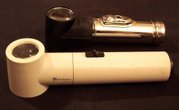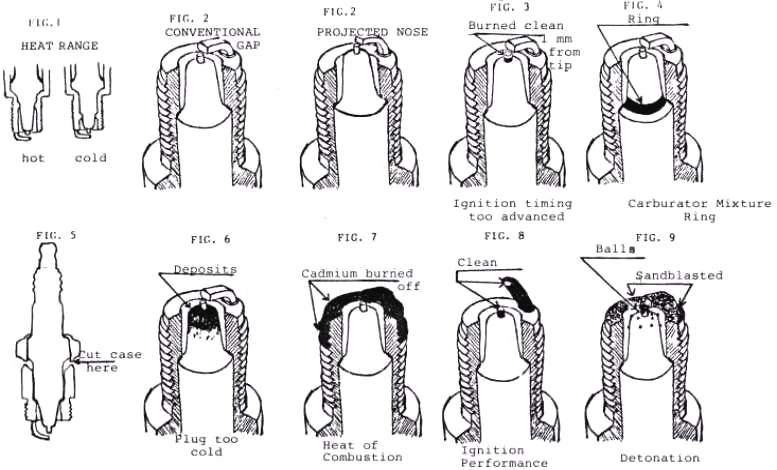Reading spark plugs for racing is a precision technique that should be distinguished from the more generic meaning of reading spark plugs, as the published information intended for commercial mechanics to diagnose engine damage is insufficiently accurate. This is because tuning racing engines is always done with engines in prime condition. These engines also require adjustment to much finer tolerances. Tuning must end when any sort of damage occurs, therefore none of the symptoms given in traditional spark plug reading charts can apply.
Reading technique[]
Reading spark plugs is a technique used by auto mechanics to diagnose conditions within an engine. Spark plugs initiate combustion in internal combustion engines. It is right inside the combustion chamber and more importantly can be removed for inspection. An examination, or "reading" of the characteristic markings on the firing end of the spark plug can indicate conditions within the running engine. The spark plug's firing end will be affected by the internal environment and will bear the marks as evidence of what is happening inside the engine while running. Usually there is no other way to know what is going on inside an engine running at peak power. The information so obtained is especially important in high performance engines to refine the adjustment of all the systems.
Where to read[]
The most relevant spark plug parts for reading are at the tip within the combustion chamber: the center and side electrodes as well as part of the insulator. The operation of the spark plug ignites a fireball and creates the characteristic marks for spark plug reading.
The size of this fireball or kernel depends on the exact composition of the mixture between the electrodes and the level of combustion chamber turbulence at the time of the spark. A small kernel will make the engine run as though the ignition timing was retarded and a large one like the timing was advanced for that individual cycle.
Reading spark plug conditions[]
Spark plug reading flashlight/magnifiers aid in reading spark plugs.

Two spark plug viewers
Accurate Reading Conditions[]
The most accurate plug readings are obtained after an engine is well tuned with new plugs and after shutting the engine at the end of a strong full throttle run. The engine shuttting down quickly and cleanly avoids misleading information giving evidence from the conditions of full power. Idle conditions may be relevant for non-racing readings and general engine diagnosis. Reading racing for racing is focussed on maximum power conditions.
Gap Type[]
Racers are concerned with only two gap styles illustrated in figure 2.
- Projected Nose
- Conventional gap
Most racing engines use projected nose, fine wire plugs, but some engines need the conventional gap fine wire plugs because of clearance problems or difficulty in cooling the plug. Surface gap, retracted gap, etc., plugs are not suitable for high performance use.
Engine conditions and impact on spark plugs[]
Heat range[]
With respect to heat range, manufactured racing engines already have most of the selection done. The stock plug is usually within two heat ranges of ideal. The only change that might be needed to use the fine wire version of the same plug (usually 1 or 2 steps hotter). For heavily modified standard engines the choice is less clear. A plug 2 to 3 ranges colder than stock and of the fine wire type would be a good starting point. Complete the ignition timing and fuel system adjustments first and then select the final heat range for the spark plug.
Figure 1 illustrates hot versus cold spark plugs. Spark plugs are capable of running anywhere from cold to hot in a given engine, depending on plug design. Use the hottest plug that won't over heat itself under the worst conditions.
A hot plug does not make an engine run hot, nor a cold plug make an engine run cold. A hot plug merely means that the insulator nose will run hotter and keep itself clean by burning off deposits.
A plug which is too cold collects carbon and fuel deposits on its insulator, which leaks energy from the ignition, causing loss of power, if allowed to continue it will foul (not spark at all).
The length of the insulator determines the heat range of a plug. Use the hottest plug that doesn't burn the tip of the center electrode.
If your plug is too cold, you will see deposits on the nose of your plug. Figure 6 illustrates this. If your plug is too hot, the porcelain will be porous looking, almost like sugar. The material which seals the center electrode to the insulator will boil out.
Voltage loss[]
As the voltage builds up in the plug, it may leak to ground through any deposits, which are on the insulator nose, robbing the spark gap of its energy. This is what happens when you foul a plug. Any conductive deposits on the insulator nose will, (even if the engine doesn't misfire) cause a reduction of energy in the spark leading to small,erratic kernels, slightly reducing power.
Ignition timing[]
Ignition timing can be seen on the center electrode tip. If the timing is too advanced by 2 to 4 degrees, the tip of the electrode will be scorched clean for about one millimeter from the tip. The center electrode will have its edges rounded from heat. The material which seals the center electrode to the insulator may boil out. This is illustrated in figure 3.
When the timing is correct or retarded, the fuel deposits on the electrode tip will extend right to the tip. So you can only see ignition advance on the plug, not retard.
Fuel mixture[]
This is the most important part of plug reading and the most misunderstood. Mechanics are often talk about "color" on their plugs. However there is only one color to look for on a plug and that is black. It is soot, the remains of combustion.
The brown color you see on a plug is only the result of gasoline additives and nothing more. In an engine which is running well, the plug will run hot enough to burn off all the brown color, leaving only white and black. Under test conditions as there will be little time to accumulate fuel deposits.
The black will be found at the base of the electrode insulator nose where the porcelain meets the metal case. This is the only place on the plug where you can see if the engine is rich or lean. This carbon forms a ring around the base of the electrode very quickly. It can be seen it after only a few seconds of full throttle running, but a couple of full throttle runs should be made so that the ring will be very clear. (See figure 4).
While learning to read plugs it will be much easier to see the mixture ring if you cut apart the spark plug and remove the porcelain from the metal case. (See figure 5.) You will see the mixture ring starting where the seal was and extending up the insulator some distance.
The optimum width of this ring is about 0 to 2mm millimeters with .5mm being ideal for many engines, more than this is too rich for most engines and many engines respond to a mixture where almost no ring is visible but you must conduct power tests to find the ideal for your situation. Make sure your heat range is correct because it may affect the mixture ring.
Engine power[]
Power produces heat and one can see the heat of combustion on the metal case of the plug. The only plugs that show this feature are the cadmium-electroplated types. Don't use the black oxide plugs because they can't show engine heat. Racing engines will produce enough heat to burn the plating off the end of the threads on the case as illustrated in figure 7. You should have 1 to 4 threads scorched by heat on your plugs. If you can't get that heat, you have a problem. Even if every other indication on the plug is perfect, the engine is not making its potential power.
Ignition performance[]
You can see the performance of your ignition system on the electrodes where the spark jumps from one to the other. The spark should burn clean a spot on both electrodes where the spark touches as illustrated in figure 8.
If the spot is small and irregularly shaped, your ignition is going bad. You should watch this spot when you are experimenting with spark plug gaps.
Detonation[]
"Detonation" is one of the worst things that can happen in a powerful engine because they are running near the edge of the envelope. It can occur for many reasons; high compression, overly advanced timing, fuel too low in octane rating, too high of a heat range spark plug or poorly shaped combustion chamber. It can often be seen on the spark plug before serious damage occurs.
You will see small balls of fuel and metal deposits on the porcelain tip and smaller balls of debris on the electrode tip. The metal case will look as if it were sandblasted (inside the engine the piston will also look sand blasted). See figure 9.
(Detonation is not entirely bad however, maximum power is always found with just a trace of detonation, not enough to be seen on the plug or to be heard by the driver, but enough to leave a slight sandblasted look (just enough to remove the carbon deposits) on the edge of the piston, after a race. (Drag racers may not have visible marks even though it is happening due to the short running time). It is theorized that the trace detonation is partially burning the otherwise unburnable mixture in crevices of the piston and chamber.)

Other observable factors[]
The information mentioned above is used in concert with other observable factors such as the operator's impressions, exhaust pipe deposits, combustion chamber and piston deposits, engine sound, actual measured performace of the engine, exhaust temperature and sometimes exhaust gas analysis.